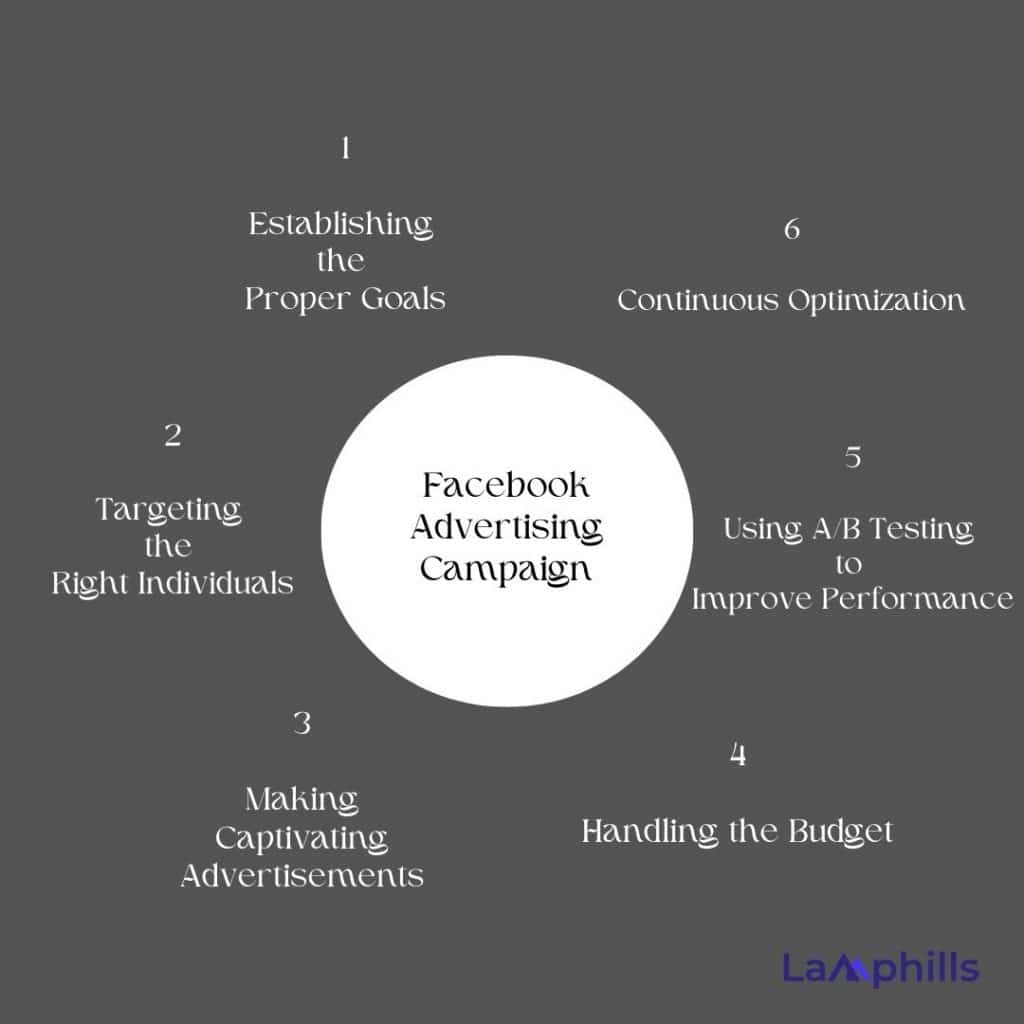Facebook advertising is a great way for your company to connect with consumers who are considering your goods or services. You can re-engage previous leads to encourage conversions and acquire new ones. You may use Facebook’s ad management features to make advertising even easier, which will make your job even easier. When I first started running Facebook advertisements, I soon saw that it wasn’t viable to try to do everything by hand. I wanted a solution to maximize my time, improve my ads, and simplify the process. I used Facebook advertising management software at that point, which revolutionized my campaign management and enhanced my outcomes. In this article, I’ll discuss my experience using the most beneficial tools.
Key Points
- The creation, tracking, and optimization of Facebook ad campaigns to achieve particular objectives is known as Facebook advertising management.
- Setting up, monitoring and modifying campaigns is possible via Facebook Ads Manager, the main tool for managing Facebook ads.
- Advertising on Facebook targets people according to their demographics, interests, and activities.
- Payment types that advertisers can select from include cost per action (CPA), cost per thousand impressions (CPM), and cost per click (CPC).
- To optimize for success, campaigns must be continuously monitored and adjusted to maximize return on investment (ROI) and ad performance.
Overview
To run advertisements on Facebook, Instagram, Messenger, or Audience Network, start with Ads Manager. Ad creation, scheduling, and location management, as well as monitoring the effectiveness of your campaigns to your marketing objectives, can all be done with this one solution.
Facebook Ads is a platform for advertising on the social media site Facebook that uses text, image, or video ads to market goods and services. It is a marketing medium that many businesses employ because of its huge audience and excellent segmentation potential.
Due to its ease of use compared to search engine advertising, small businesses frequently use it to find restricted promotions both regionally and over time. Facebook ad campaigns are best designed and tracked by a professional, as is the case with all digital marketing platforms.
Also Read: Top Skills Every Advertising Manager Needs to Succeed
My Journey
I didn’t realize how advanced and potent Facebook could be when I first engaged with advertising. As is common, I thought that promoting a few posts and focusing on a large readership would provide benefits. I soon discovered, however, that Facebook ad management was an art that required the proper tools and technique.
I initially came across Facebook advertisements when I needed to advertise my little online store. Due to my limited funds, I needed to find a means to reach more people without going over budget. Given Facebook’s wide reach, I made the decision to give it a try. Soon, though, I discovered that running an advertisement alone was insufficient. Copywriting, budget optimization, ad creative, and audience targeting were just a few of the numerous variables. In other words, it was dominant.
Hours were spent on experiments and studies. The value of knowing the client was among the most important lessons I took away from my early experience. Facebook offers a wide range of targeting choices that let me determine my audience’s interests, habits, and even previous encounters with my business. Because I believed that a larger audience would result in more leads, I initially tried to reach everyone. I soon discovered, however, that more engagement and conversions were the result of a very particular and limited audience.
Measuring Success
I was completely preoccupied with obtaining impressions and clicks in the beginning. But as I accumulated more expertise, I saw that these numbers weren’t always indicative of successful businesses. The conversion rate—the number of customers who made a purchase from my store after clicking on an advertisement—was what mattered most. In addition to tracking clicks, I began tracking the most important activities, such as add-to-cart events, transactions, and return on ad spend (ROAS), using Facebook’s Ads Manager and third-party tools. By refocusing my attention, I was able to improve my approach and provide greater attention to the campaigns that were producing tangible outcomes.
Facebook Advertising Campaign
The decision to start my first Facebook advertising campaign is still fresh in my mind. I was eager to discover a means to expand my consumer base without going over my tight budget because my firm was only getting started at the time. The idea of launching into a platform this large and dynamic was difficult, even though I had heard so much about the effectiveness of Facebook ads. My goal when I started my first Facebook ad campaign was to increase sales for my jewelry company online. My initial budget was a modest $10 a day, but I soon discovered that Facebook ads needed more than just setup. Strategy and continuous tweaking were key to the success. I used the strategies listed below:
#1. Establishing the Proper Goals
Developing a conversion campaign was my main emphasis because I wanted to increase conversions. To reach new potential consumers with comparable interests, I made a lookalike crowd and used Facebook’s custom audience option to retarget my current clientele.
#2. Targeting the Right Individuals
Focusing on a smaller audience had a significant impact. My engagement skyrocketed once I narrowed my target to ladies between the ages of 25 and 45 who were interested in jewelry and fashion. My performance improved because I was able to fine-tune my audience using Facebook’s targeting capabilities.
#3. Making Captivating Advertisements
Videos worked better than static graphics in the ad formats I examined. The most clicked-through videos were short, simple videos of me wearing my jewelry. Additionally, compared to simple product photographs, I discovered that lifestyle photos connected with my audience more. I rapidly discovered that having good graphics was important.
#4. Handling the Budget
My money was first divided among several ad sets, but I quickly began to devote more to the top-performing advertisements. Metrics like cost per conversion helped me make better budget choices and cut down on unnecessary spending.
#5. Using A/B Testing to Improve Performance
Using A/B testing, I was able to determine what worked. The title “Shop Exclusive Handmade Jewelry Now” worked better than “Discover Unique Handmade Jewelry,” according to my test. These few adjustments significantly affected my conversions and click-through rates.
#6. Continuous Optimization
Campaigns need to be constantly monitored. I regularly reviewed and tweaked my advertising according to their results. I changed the artwork when an advertisement began to lose viewers’ attention and it had noticeable effects.
My first campaign ended with 50 new clients and over 1,000 website views for a total of roughly $500 spent. For me, the most important lesson was that developing a successful Facebook ad campaign requires testing, tweaking, and improvement rather than pure luck. Facebook’s robust features allowed for learning and campaign improvement.

Facebook Advertising Management Software
Managing everything by hand became too much to handle when I initially started running Facebook advertisements. At that point, I came across Facebook advertising management software, which had a profound impact. In addition to saving me time, these technologies enhanced my ad performance by providing better insights and automating tiresome activities. To scale my campaigns without sacrificing my creative or financial control, I discovered that Facebook advertising management software was essential. The Facebook advertising management software is as follows:
#1. AdEspresso
It was AdEspresso that I tried first. For me, it revolutionized A/B testing by making it simpler. I may test several ad variations simultaneously to determine the most effective headlines, imagery, or targeting. Quick campaign optimization and time savings were made possible by the user-friendly interface.
#2. RevealBot
I then automated it with Revealbot. Its rule-based automation capabilities, such as stopping ineffective advertisements or boosting the budget for those that work well, were fantastic. Knowing that this program was optimizing my advertising even while I wasn’t looking provided me peace of mind.
#3. Hootsuite Ads
In addition to other social media channels, Hootsuite Ads helped manage my Facebook ads. It enabled me to monitor and control everything in one location and provided me with a comprehensive picture of every campaign I ran.
How to Set Up Facebook Advertising Management
When I initially started using Facebook advertising, it was really difficult to handle everything by hand. It can be intimidating to set up Facebook advertising management at first, but it got a lot easier for me after I had a clear framework and the right tools. Through goal-setting, campaign planning, Facebook Pixel, and automation, I managed to execute more successful and efficient campaigns without being overburdened. I soon saw that to manage and track my campaigns efficiently, I required a streamlined strategy. I configured my Facebook advertising management in the manner described below to increase efficiency and enhance outcomes:
#1. Establish Specific Goals
I started by defining my objectives before launching into Facebook Ads Manager. Having a clear goal was crucial, regardless of whether I was trying to improve conversions, generate leads, or increase website traffic. Choosing the appropriate campaign aim was the cornerstone of my setup because Facebook offers a variety of them, including awareness, engagement, and conversion.
#2. Plan Ad Sets and Campaigns
I soon discovered that the secret to managing my campaigns was organization. To target particular demographics, I developed unique ad sets for each campaign, which were devoted to a single goal (such as engagement or sales). A lookalike audience can be the emphasis of one set of ads, while interest-based targeting might be the focus of another. With this configuration, I was able to maintain organization and ease of oversight. By not combining all of the campaigns into one, I was able to rapidly determine which audience was doing the best.
#3. Install Facebook Pixel
For me, the Facebook Pixel was revolutionary. By installing it on my website, I was able to retarget visitors, monitor conversions, and assess the success of my advertisements. I was able to improve my strategy and boost conversions by creating unique audiences of site visitors who did not convert once the pixel was set up.
#4. Everything should be A/B tested.
I used A/B testing as one of my initial strategies. A variety of call-to-action buttons, headlines, pictures, and even audience groups were tested. By doing this, I was able to determine which combinations produced the best results and improve my ads using actual facts rather than assumptions. I improved my ad effectiveness and decreased my cost per click by constantly testing and fine-tuning my advertising.
#5. Effectively Utilize Facebook Ads Manager
Gaining familiarity with Facebook Ads Manager’s features was necessary to manage everything within it. I started by arranging the columns in the reporting section to show the metrics that were most crucial to me, such as cost per conversion, click-through rate (CTR), and return on ad spend (ROAS). With this configuration, I was able to monitor performance without searching through pointless data. To broadcast advertisements only during the times when my audience was most engaged, I also used the scheduling option. My budget was further stretched without sacrificing quality as a result.
#6. Make Use of an Ad Management Tool
I needed a simpler way to handle things as my campaigns expanded. I then started using programs like Revealbot and AdEspresso. However, I was able to automate several chores, such as budget modifications and A/B testing, thanks to these technologies. Ad testing was made easy with AdEspresso, and I was able to automate rule-based changes, such as stopping underperforming advertisements, with Revealbot. I was able to concentrate more on my creative approach and save hours each week because of this setup.
#7. Regularly check and make adjustments
After my Facebook advertising management system was operational, I didn’t just forget about it. I established a daily routine of checking my campaigns, analyzing the important KPIs, and making minor tweaks as necessary. I would change my budget to better-performing advertising, update the creative, or adjust the targeting if an ad wasn’t doing well.
The Importance of Facebook Advertising Management
My company’s success was greatly impacted by Facebook advertising management. It transformed my random advertising initiatives into a data-driven, effective approach that continuously produced outcomes. As I grew my campaigns, efficiently managing Facebook advertisements became essential to my company. I initially attempted to manage everything by hand, but I soon saw that this was ineffective and inconsistent with my ad expenditure. Facebook advertising management offers the following perks:
#1. Preserving Time and Energy
Automating performance tracking and A/B testing was made easier with the use of management solutions like AdEspresso. Instead of always watching advertisements, I was able to concentrate on producing better material, saving me hours every week.
#2. Budgetary Management
It’s easy to squander money on ineffective advertisements if management isn’t done right. I made my investment far more efficient by actively managing my campaigns, which decreased expenses and raised my return on ad spend (ROAS).
#3. Enhancing Advertising Performance
Constant campaign optimization was made possible by Facebook advertising management. Through consistent tweaking of targeting, ad creatives, and budgets, I made sure my advertisements were seen by the correct people and had the greatest outcomes.
#4. Improved Understanding
Although Facebook Ads Manager offers comprehensive data, effective ad management allowed me to spot what was effective right away. I was able to make wise selections and enhance subsequent campaigns thanks to this realization.
Also Read: What is Social Media Management? Everything You Need to Know
What is FB Ads Management?
The process of developing, planning, overseeing, and refining Facebook advertising campaigns is known as “FB Ads Management.” It includes deciding on appropriate marketing goals, allocating funds, focusing on particular demographics, creating captivating advertisements, and regularly adjusting campaigns to improve results. All of these activities are managed by Facebook Ads Manager, which also offers tools to monitor important metrics, modify tactics, and optimize ad efficacy.
How does Facebook advertising work?
Businesses can develop ads on Facebook that are shown to users according to their demographics, interests, and actions. To create campaigns, specify objectives (such as increasing traffic, conversions, or awareness), and target particular demographics, advertisers utilize Facebook Ads Manager. The selected audience is subsequently shown the ads via Facebook’s algorithm, which also keeps track of clicks, engagement, and transactions. The payment model that advertisers choose determines how much they pay; this can be per action (CPA), per thousand impressions (CPM), or per click (CPC). In order to guarantee that advertisements function well and yield a good return on investment (ROI), continuous optimization is of the essence.
Conclusion
Facebook advertising management is a big challenge. It is a complex process that involves ongoing testing, learning, and improvement. However, if the proper methods and resources are used, it can be one of the best ways to expand a company. It has been a path of trial and error for me, but I have gained a lot of knowledge in the process. Know your audience at all times, keep testing, and make use of the greatest technologies available to make your job easier. With enough time and work, Facebook advertising can lead to a variety of options, regardless of your stage of development.
My life changed when I started using Facebook advertising management software. Not only did AdEspresso, Revealbot, and Hootsuite Ads save me time, but they also improved the effectiveness of my campaigns. By automating time-consuming processes, testing ad versions, and obtaining more insightful data, I was able to maintain my advertising approach while concentrating on growing my business. You need these tools if you’re passionate about getting better results from your Facebook ads.
Related Articles
- The Complete Guide to Becoming an Advertising Manager
- How to Create a Facebook Ad: A Step-by-Step Guide for Beginners
- Facebook Ads to Inspire Your Next Campaign (+ Tips on Creating One)
- 20+ BEST SOCIAL MEDIA ADVERTISING EXAMPLES FOR 2024
- A Guide to Paid Media Management: Best Strategies






